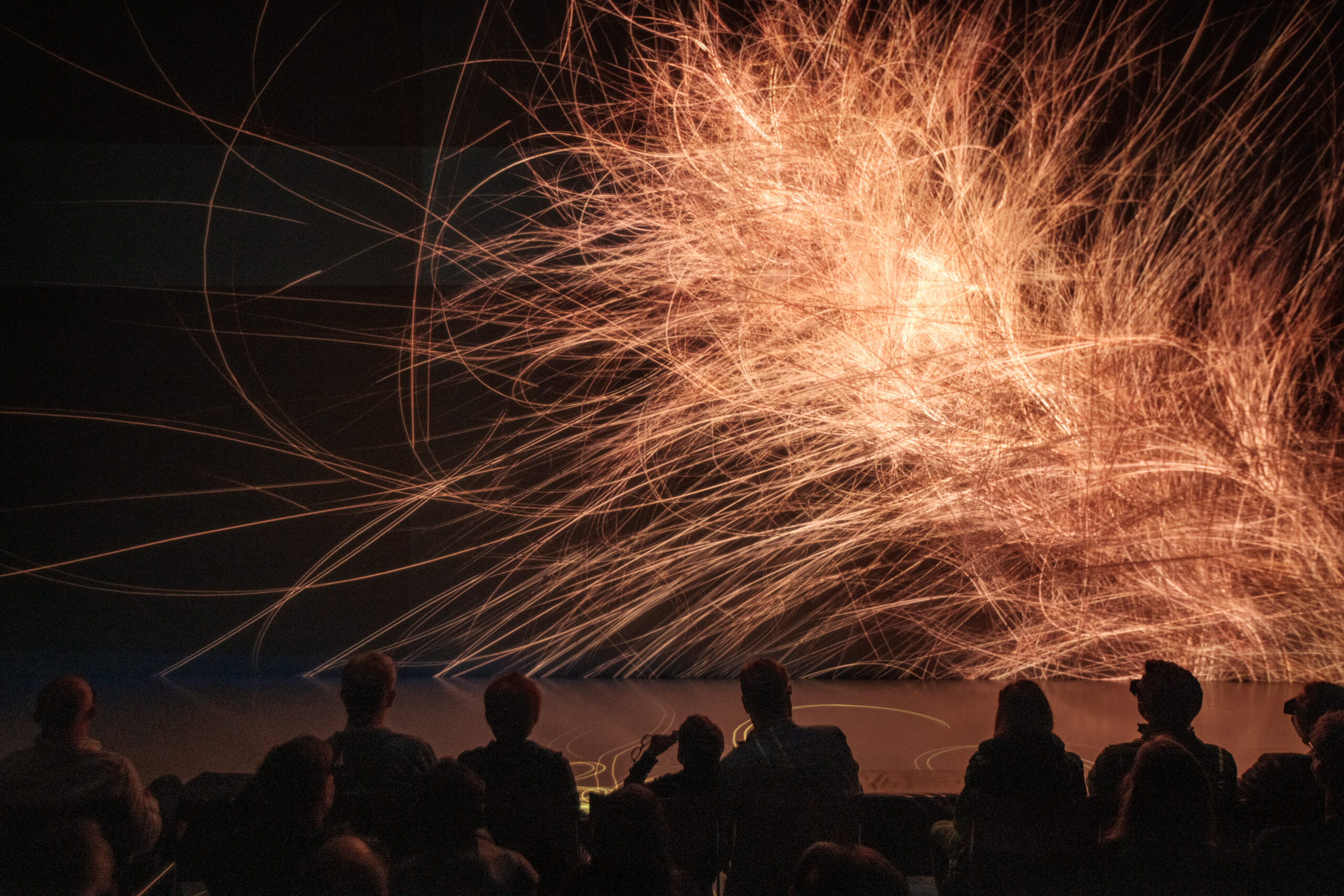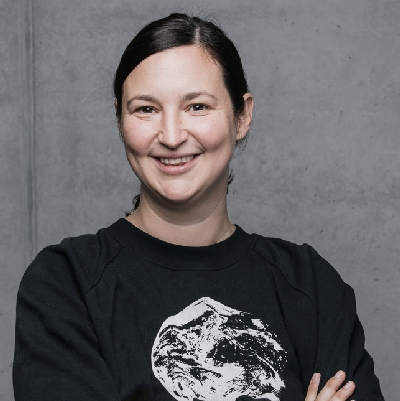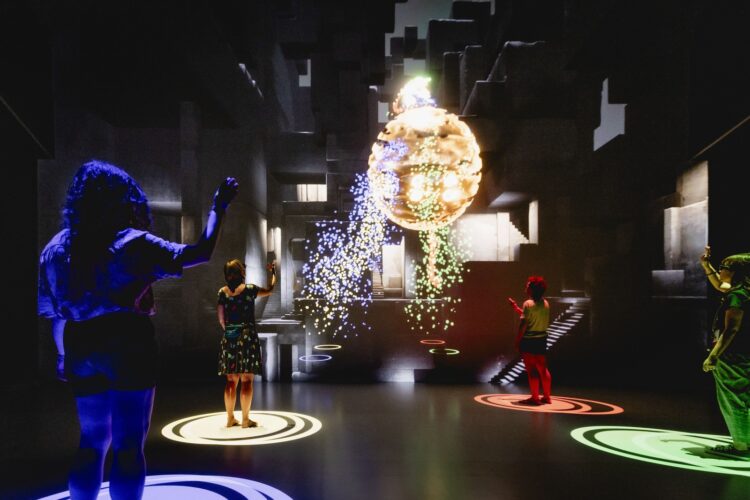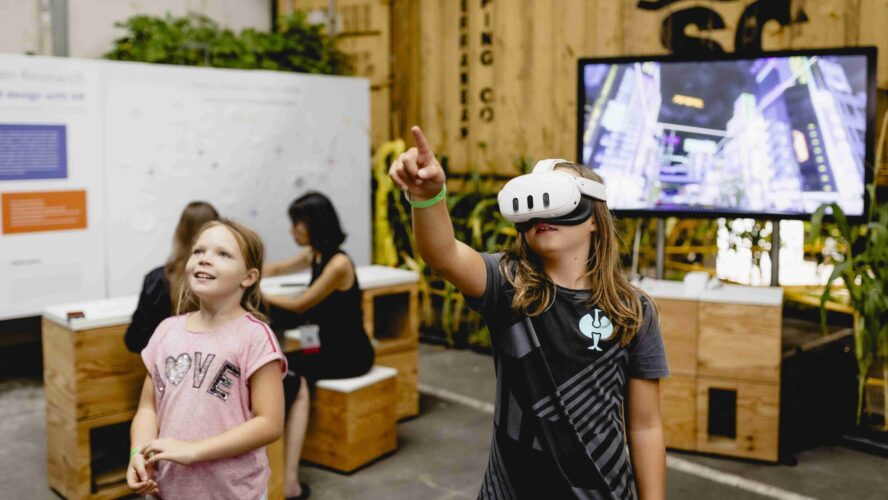At the Ars Electronica Futurelab, we ask ourselves: What kind of impact does our work have? How does it affect the audience who interacts with what we create? What kind of impact do we aim for on a public level? How does it influence our partners and their institutions? And how does it impact us at the Futurelab, as a team and as individuals? Basically, why are we doing what we do?
This dynamic concept assesses cultural and artistic innovation, technological advancements, and societal transformation in key Future Impact Areas.
Approaches for assessing impact and refining methodologies in rapidly evolving artistic, technological, and societal landscapes.
Turning uncertainty into opportunity: Learn more about the underlying strategies we can use to create an impact if the only constant is change.
Future Impact Creation is an evolving approach to understand and shape the impact of our work on from different angles:
- Socially: How are we contributing to society with what we do?
- Technologically: How are we pushing the boundaries of technology?
- Artistically: What’s the cultural or artistic significance of our work?
These are the kinds of questions that guide us in making sure we’re creating relevant, meaningful work.
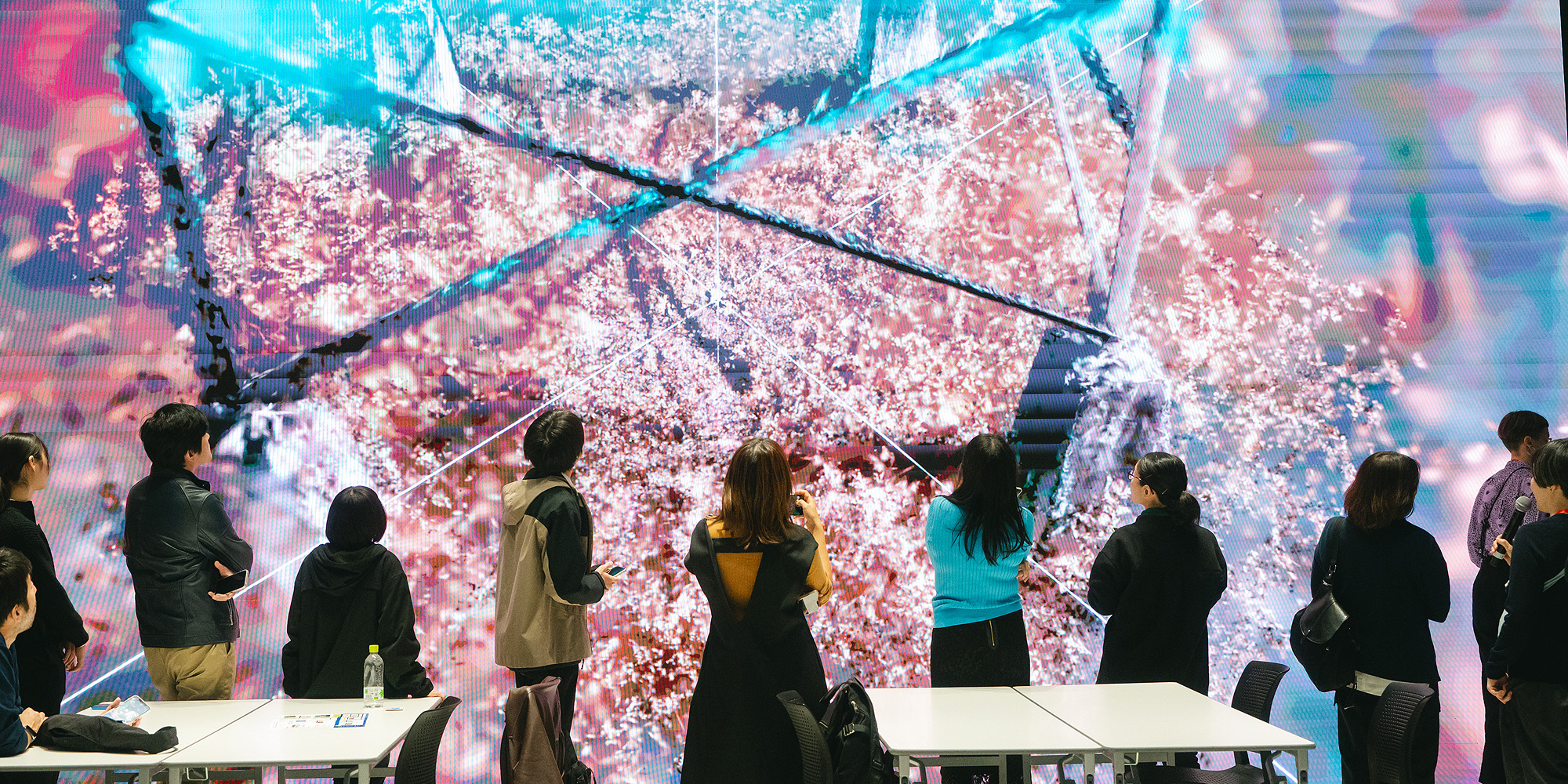
Future Impact Creation Framework
At Ars Electronica Futurelab, our projects are designed to spark change – whether in perspective, knowledge, systems, or technologies. They target future transformations, but how do we measure their future impact? Especially when a project extends beyond its immediate goals, shaping new ideas, methodologies, and applications in unexpected ways?
Future Impact Creation helps us understand and shape the effects of our projects in a rapidly changing world. It reveals both intended and unexpected effects, making our work more meaningful and influential. By learning from past experiences and exploring new perspectives, we generate valuable insights for our collaborators, other interested parties like researchers and fellow artists, the Futurelab team itself and society as a whole.
Future Impact Creation is an evolving effort to:
- establish definitions and methods for assessing impact in artistic, technological, and societal contexts,
- integrate impact assessment into project workflows, allowing for reflection and adaptation throughout the process,
- develop and test strategies to create impact,
- provide tools for internal and external assessment and communication, making the significance of projects more tangible and comparable,
- acknowledge uncertainty and experimentation as key factors in the creation of knowledge and innovation.
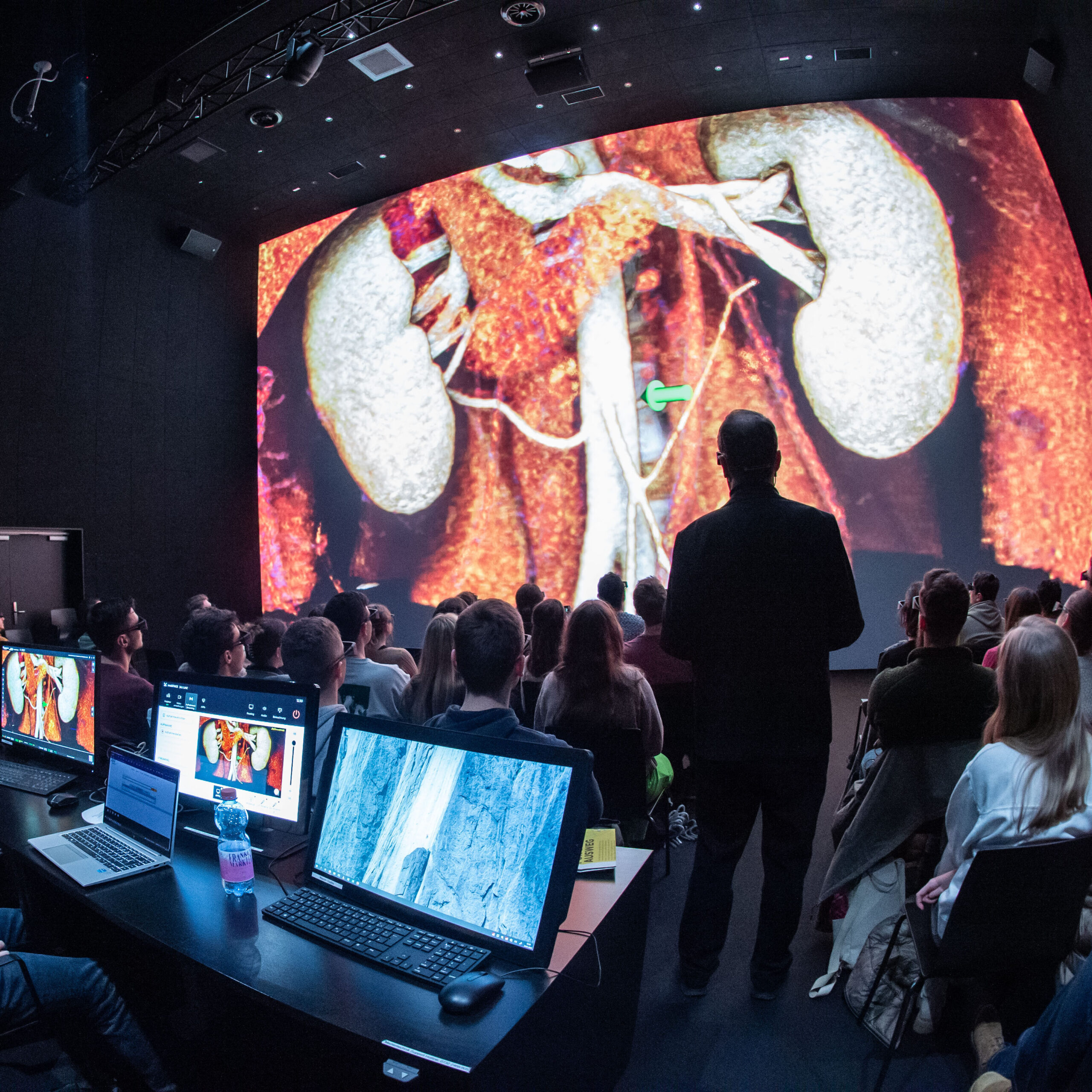
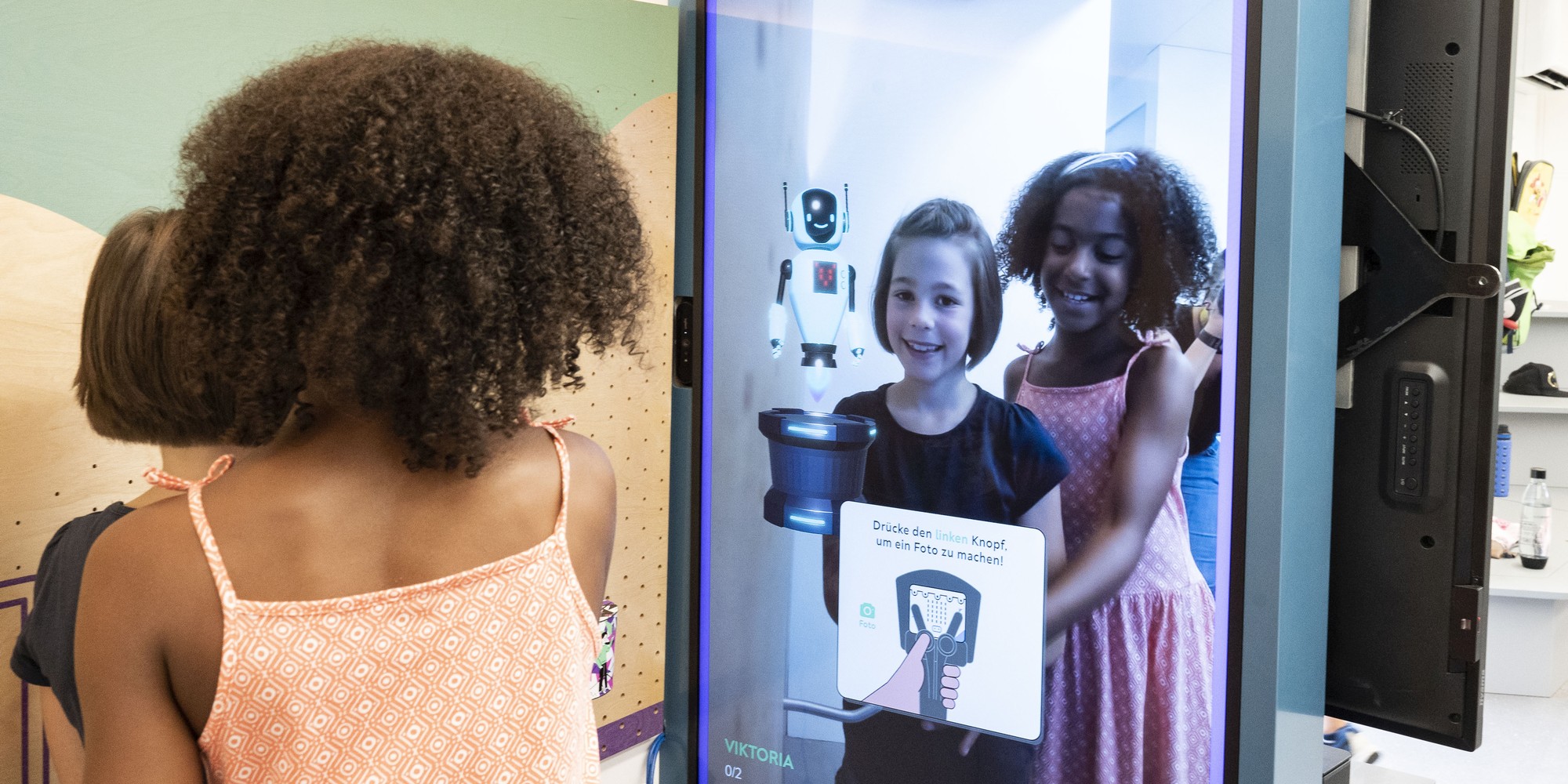
Future Impact Areas
Building on Ars Electronica’s thematic triangle of art, technology, and society, Future Impact Creation explores the effects and outcomes in these three areas and their intersections – across disciplines and over time. This model maps out how artistic, technological, and societal initiatives can contribute to cultural discourse, scientific innovation, and social transformation. It also acknowledges the complex, often overlapping nature of impact, where creative processes spark ripple effects in unexpected ways. Depending on the project’s nature, key dimensions of impact within each area can be identified, inviting ongoing reflection on how projects can shape the present and future in these areas – both in intended outcomes and emergent possibilities.
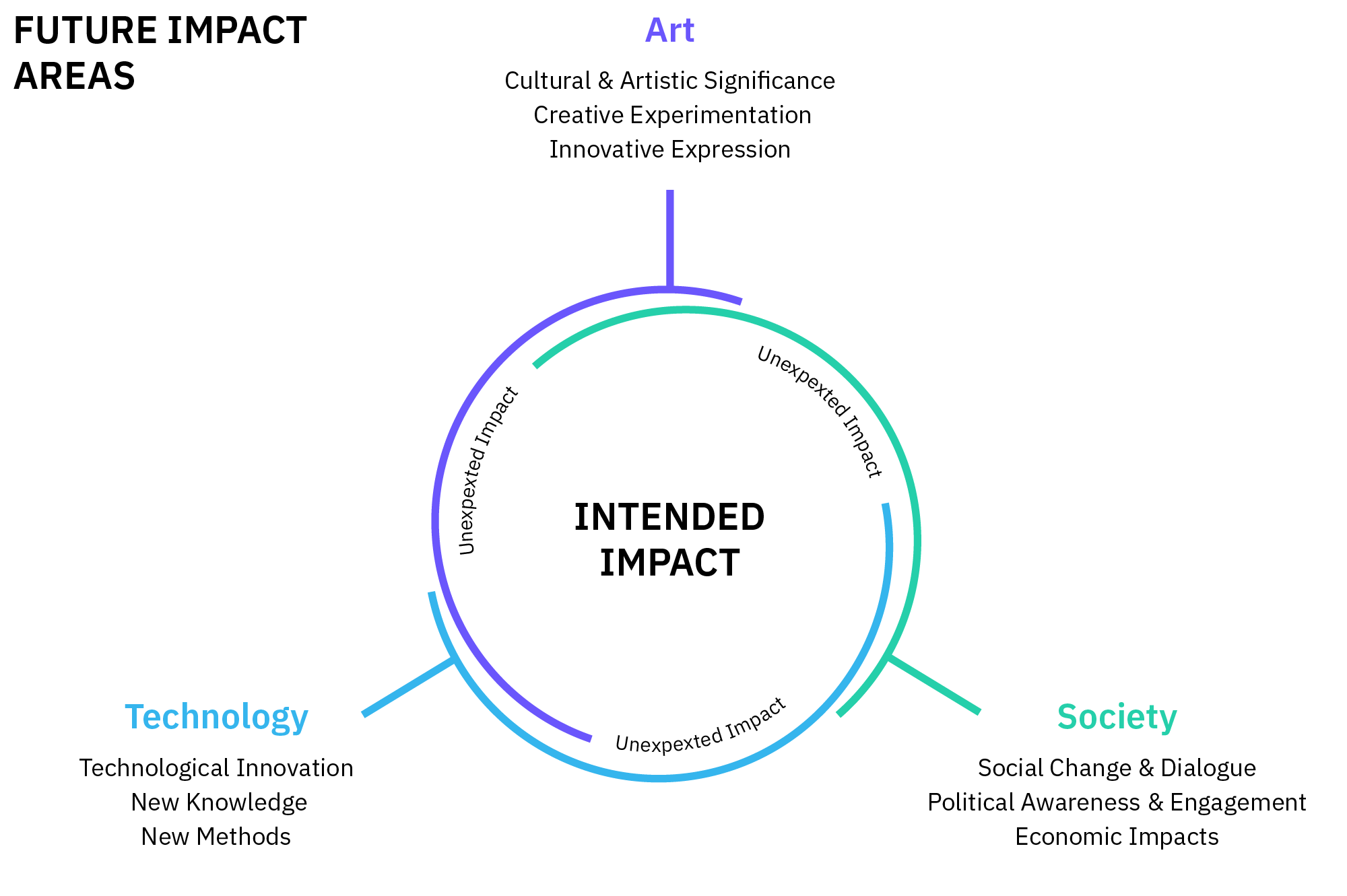
In addition to external impacts, the Future Impact Creation Framework places particular emphasis on internal value of our projects within the Ars Electronica ecosystem, always adhering to the principle of serendipity by observing unexpected outcomes and the emergence of new strategies.
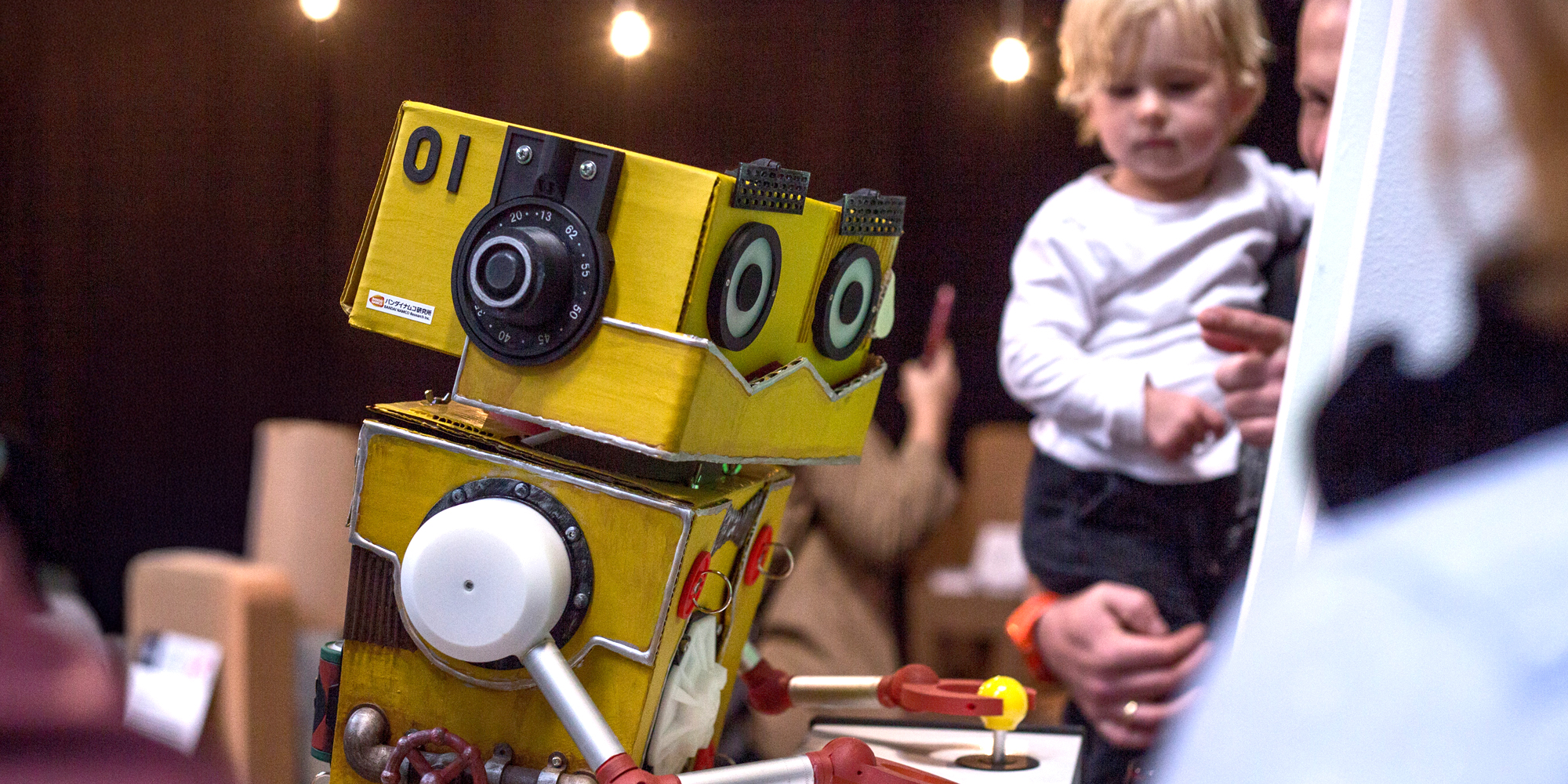
Tools & Methods
Reflection is key
Through tools like Project Therapy Sessions, teams assess intended vs. actual outcomes, uncover unexpected impacts, and adapt future work. Rooted in care and transparency, this iterative practice deepens impact, strengthens methodologies, and builds a culture of continuous learning and research.
The Future Impact Creation Process consists of four steps. It begins by clarifying the intended impact of a project and identifying the target groups. In the next phase, methods and indicators are defined to plan how this impact can be observed and measured over time. The implementation phase reveals what has been created and what effects—intended or unexpected—have emerged. Finally, the outcomes are reflected upon in relation to the original goals, generating insights that inform and guide future initiatives.
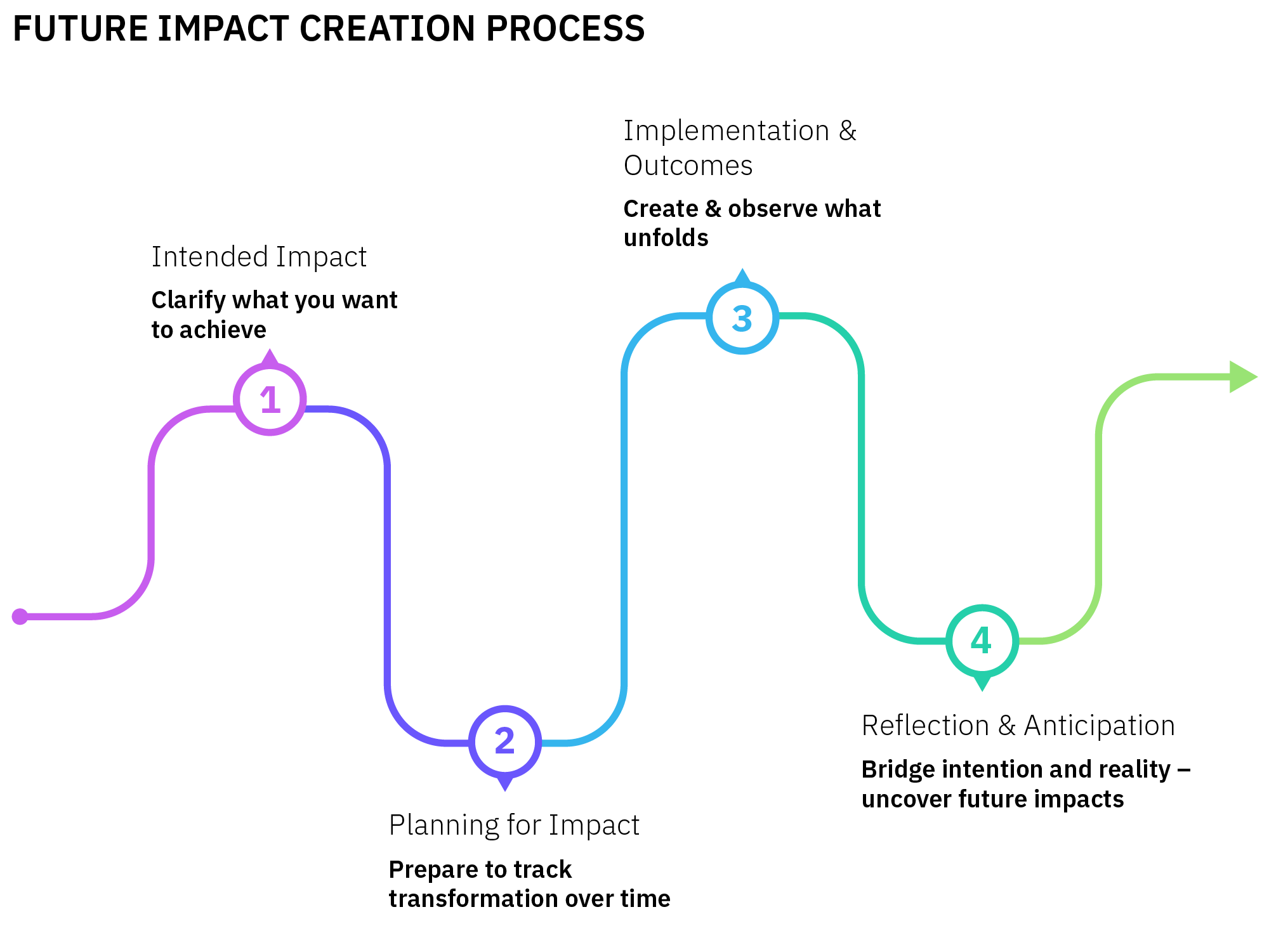
Levels of Impact
Impact occurs at multiple levels – from individual to systemic – shaping both personal and structural change through interconnected stages like knowledge transfer, discourse shift, attitude transformation, capacity building, action, and long-term systemic change.
An Open Process
Not every project needs assessment, not every work, the same evaluation methodology. Future Impact Creation is a work in progress by design, allowing for adaptability across various projects and disciplines. While often nonlinear, this process emphasizes potential and ripple effects rather than direct causality. By continuously refining this approach, we aim to create a more systematic yet open-ended understanding of how transformation unfolds.
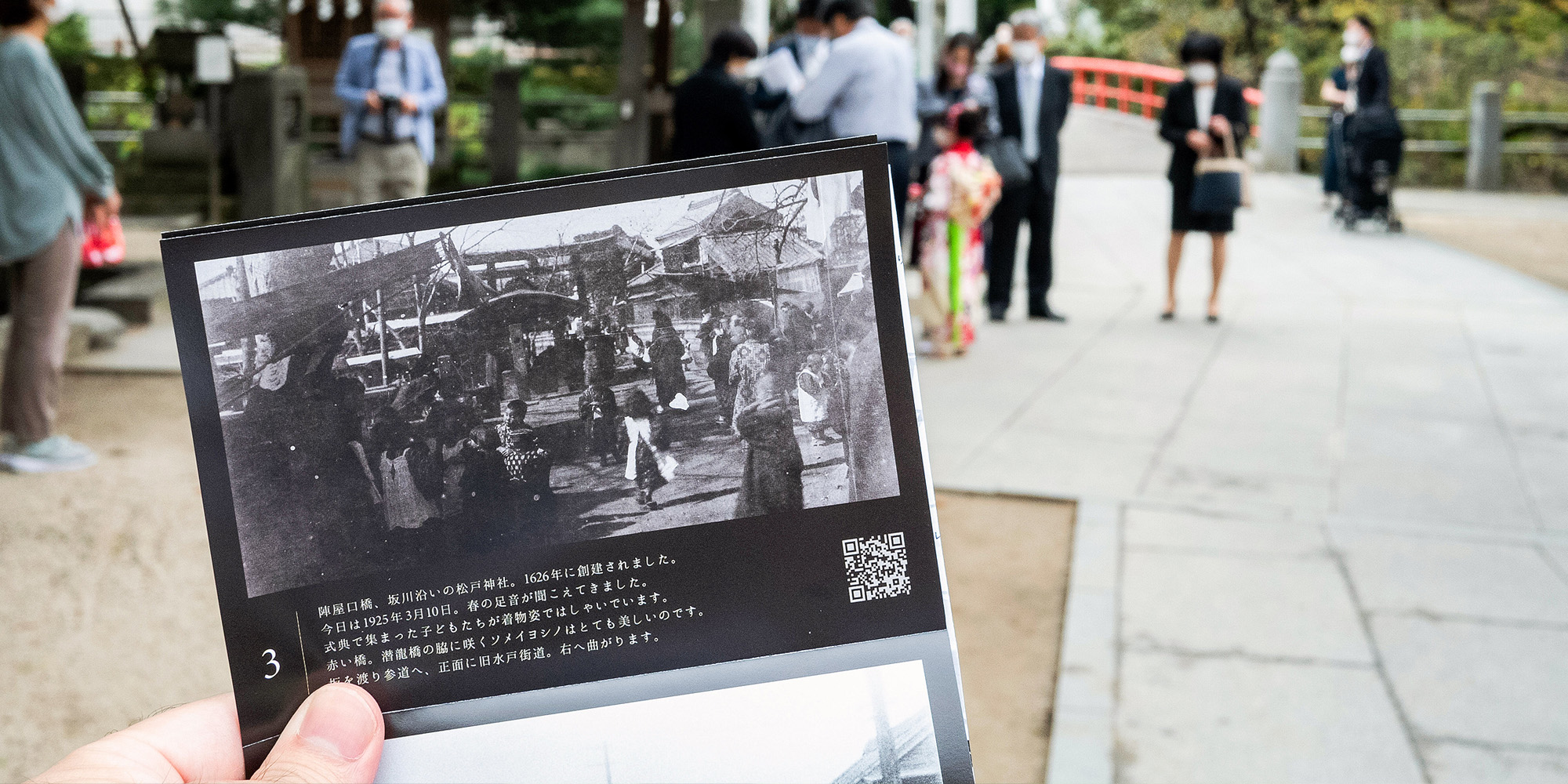
Deep Dive
Turning Uncertainty into Opportunity
Wicked Problems, Grand Challenges, Polycrisis, Hyper Problem Deep issues, name it as you like … The world we operate in today is increasingly shaped by VUCA – an acronym describing an environment that is Volatile, Uncertain, Complex, and Ambiguous. Originally coined in military strategy, VUCA is now widely used to characterize the challenges faced across various fields, from business and technology to the arts and social sciences. At the same time our strategy to face this VUCA world includes artistic methods and experimentation as well as speculation to evoke change and discuss the future. In this realm of artistic, technological, and societal innovation, outcomes are rarely linear or predictable.
So, what are strategies we can use to create an impact if the only constant is change? Future Impact Creation seeks to examine how we can trigger and guide change at the societal, technological, artistic, and individual levels. The examination of obstacles and drivers of change is a core focus of Future Impact Creation. Here, traditional evaluation methods—such as predefined success metrics and rigid performance indicators—struggle to capture the broader, evolving impact of such creative and experimental projects in an uncertain world. This calls for a new approach that embraces uncertainty rather than trying to eliminate it.
To navigate this complexity, the Future Impact Creation framework proposes:
- Adaptive Reflection: Regularly assessing projects through open-ended reflection rather than rigid benchmarks, to acknowledge both intended and unexpected impacts.
- Contextual Understanding: Assessing projects within their broader societal, artistic, and technological ecosystems, rather than isolating them from their evolving surroundings.
- Embracing Uncertainty: Recognizing that experimental work often generates impact in unexpected ways and allowing room for emergent insights. Even though human brains naturally seek labels and categories, ambiguity is an essential aspect of innovation and creativity.
- Beyond KPIs: Key Transformation Indicators (KTIs): Shifting from fixed success metrics to indicators that capture meaningful transformation—such as shifts in discourse, emerging strategies, or cultural resonance.
Instead of seeing unpredictability as an obstacle, Future Impact Creation views it as a fertile ground for discovery. Through continuous learning, reflection, and adaptation, we can refine our understanding of impact – ensuring that projects not only respond to change but actively shape the future. The aim is to develop a structured yet flexible process to assess and communicate such future impact across different dimensions within these special circumstances. This includes intended impact – what a project sets out to achieve – and the actual outcomes as well as unexpected impact – the unforeseen effects that arise through experimentation and chance.
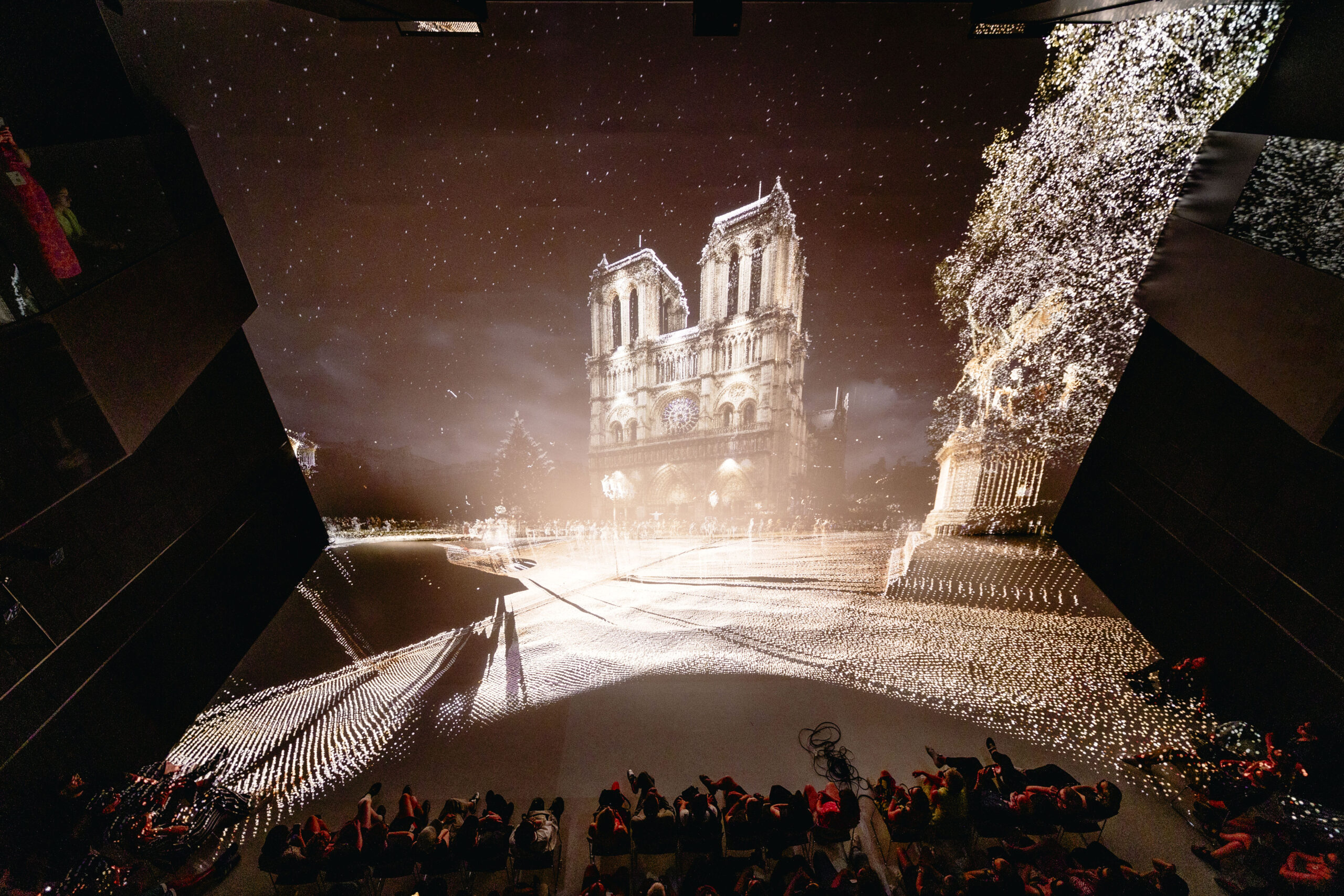
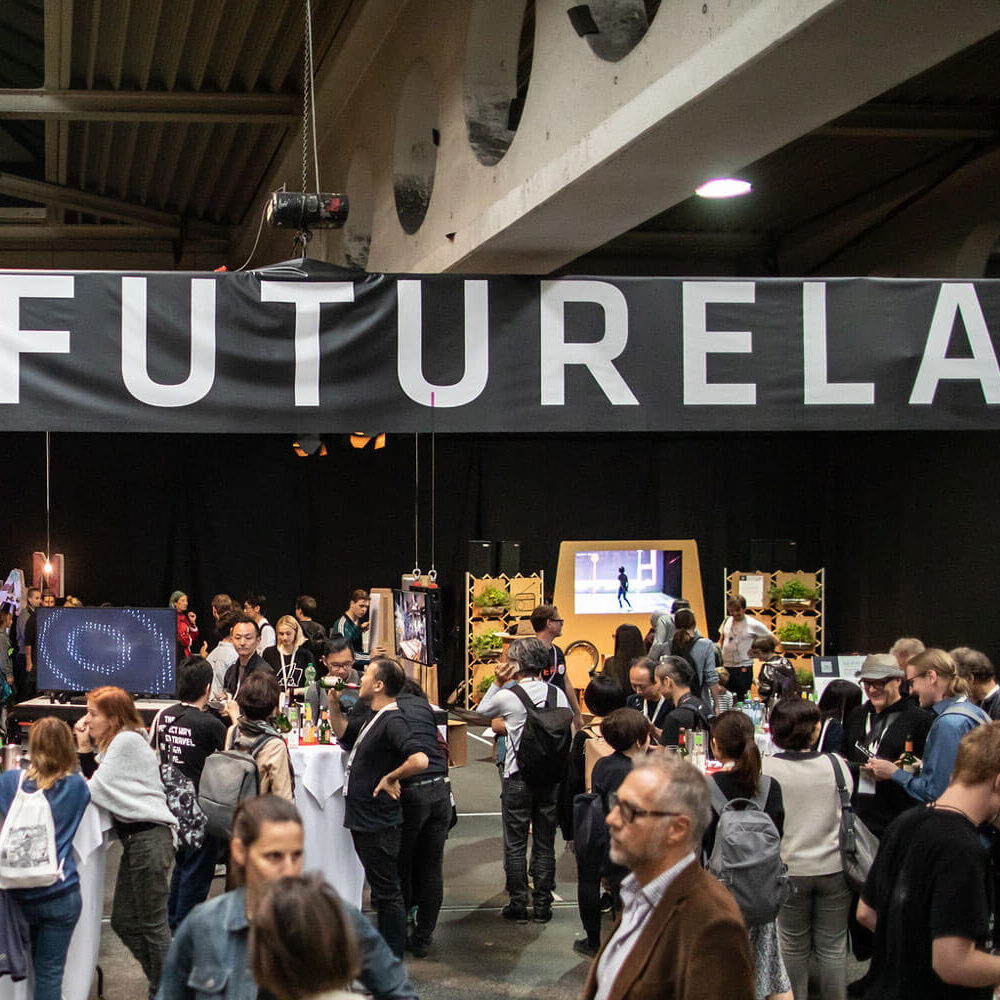
Glossary
Future Impact Areas: A model based on Ars Electronica’s thematic triangle of Art, Technology, and Society, which explores areas where impacts can be observed and how they intersect.
Future Impact Creation: A framework for defining and evaluating the impact of projects in artistic, technological, and societal contexts.
Intended Impact: The planned or desired outcomes of a project.
Key Transformation Indicators (KTIs): Shifting from fixed success metrics to indicators that capture meaningful transformation, such as changes in discourse, emerging strategies, or cultural resonance.
Outcomes: The actual results or effects of a project, including both intended and unintended impacts. Analyzed to assess success and identify areas for improvement.
Project: A long-term collaboration or research initiative involving partners from art, business, culture, research, and education, within which works are created.
Project Therapy Sessions: Practice to analyze intended impacts, actual outcomes, and unexpected effects, helping refine goals and align aspirations with results.
Unexpected Impact: Unforeseen effects or outcomes that arise unexpectedly.
Works: Tangible creations produced by Ars Electronica Futurelab for (public) display within a project, often through innovative artistic and interdisciplinary methods.
Maria Pfeifer is Head of Future Impact Creation and
Key Researcher for Future Narratives at the Ars Electronica Futurelab. She develops strategies to explore and communicate the transformative potential of artistic and technological innovation in uncertain times.
